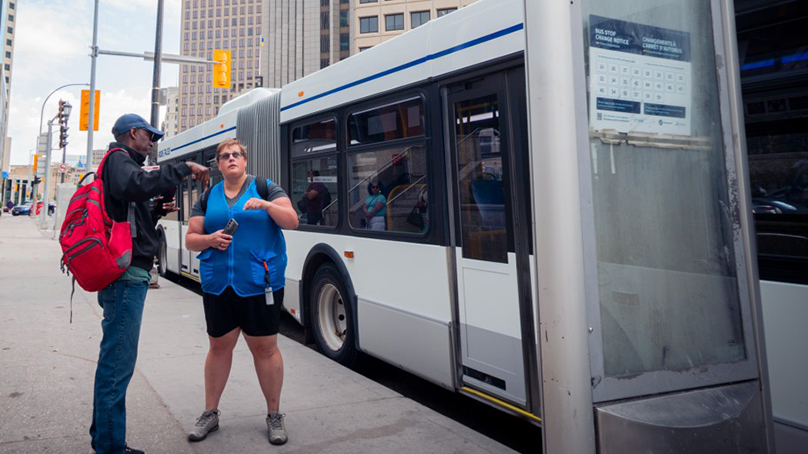
Hundreds of thousands of Winnipeggers tried the Primary Transit Network and its feeder routes in its first months. As part of our commitment to follow through and address issues with the new network, we’ve been monitoring reactions closely.
We’re so grateful to everyone who has shared constructive criticism as we adjust together. It helps us focus our efforts to make improvements.
We’re less grateful to folks who’ve been spreading misinformation online. Here are some of the myths we’re seeing repeated and the truth behind them:
The myth: This network was designed by people who never take the bus
Reality: Planners who work in Transit Service Development are required to take the bus regularly, and do!
If you’ve ever met a transit planner, chances are you’ve met a self-professed transit nerd. These folks are not avoiding the bus.
In fact, as a team they are committed to riding the bus regularly, so they have first-hand knowledge of the passenger experience.
The myth: Transit changed networks to cut service and save money
Reality: There is more service on the road now than there has been in the past five years
Winnipeg Transit did not cut any service hours when it introduced the new network. In fact, we just restored service to pre-pandemic levels for the first time in five years. There are more buses and operators on the road now than there have been since 2020.
What has changed is how service hours are allocated. Our network is designed with frequency and span of service targets for all routes. This means we have set service levels for how often a bus comes on a given route and how many hours a route is in service.
We recognize the span of service isn’t cutting it for customers on some routes and in some areas. We expect this will be among the top priorities for when we make significant changes after a full year of gathering data and feedback.
The myth: Transit cut service from central and Downtown neighbourhoods
Reality: Access to top-of-line service gets better the closer you get to the centre of the city
As famous transit advocate Jarrett Walker says, ‘Frequency is freedom.’ And the closer you move to the centre of Winnipeg, the greater your access is to multiple high-frequency bus lines. These lines come often enough that you don’t need to check a schedule during the busier times of the day. And they are designed differently than other routes. They have fewer stops.
It’s challenging to maintain frequency on bus routes with too many stops. They go slow and are more prone to falling behind schedule. This means that on our most frequent routes, you need to walk a little further to get to a stop. It will be closer to the distance you might walk to reach a subway station in a major city.
Prior to the change, Winnipeg’s older, more central areas had stops far too close together for this kind of service. In many cases, these stops were placed before we had standards and guidelines for how far apart they should be.
It may seem counterintuitive, but strategically removing stops makes buses run better. And we want the best service available in areas where it’s used most.
The myth: More buses are passing passengers up this fall
Reality: September is always a challenging month for Transit performance
Back to school is an exciting time. People wake up early to test their new commutes. University students show up for every class. People start routines they later decide aren’t for them.
All this translates to many more people travelling in peak periods than every other month of the year. It also means buses passing up passengers far more often.
We are monitoring pass-ups extra close this year because the system is new, and we have some capacity to shift service where needed. For example, we’re running more articulated buses now on the F8 to boost capacity.
The myth: Complaining to 311 is a waste of time
Reality: We’re listening and already making changes based on your feedback
Your feedback is helping us make small tweaks to our network now. And it will help us figure out what bigger changes are most important after a year.
Here’s some of the small changes we’ve made so far:
We relocated bus stops at six locations for easier access (e.g. reducing walking distance, putting stops closer to controlled crossings).
We added articulated buses to reduce crowding on Route F8 (Pembina-Henderson Highway)
We expanded On-Request service to serve growing communities with additional buses to zones 101 (South St. Vital), 102 (Sage Creek/Windsor Park), 103 (North West), 106 (North East), 111 (Waverley West) and 112 (Whyte Ridge/West Fort Garry)
We improved schedules for three routes with poor on-time performance, with full rewrites to come this winter to the D12 Ellice, D13 Sargent, and D16 Academy-Notre Dame
The myth: Everyone hates the new network
Reality: We’re hearing positive stories about how it’s working well for some riders
We’re getting a handful of commendations through 311 and seeing and hearing positive experiences on social media and in person. We know some people appreciate the ease of taking a more direct route or just showing up at a stop with frequent service. We’re hearing people say they love how fast F and FX lines run, and others who use On-Request all the time within their communities.
You can share your thoughts on the new network using our online form.
